
Increasing urban density rather than continuing to expand outwards is the answer to Sydney's urgent housing shortfall, NSW Premier Chris Minns says.
Expanding outwards into untapped areas for development in many cases required stretching public services beyond what the state government can provide, he says.
"We just can’t add another street to the western fringe of Sydney every time we need more housing ... because you have to stretch social infrastructure over a greater plain," Mr Minns told a Western Sydney leadership forum on Thursday.
"Frankly, we don't have the resources or the tax base to build Westmead 2.0... every five to 10 years.
"We have to build housing where there's existing infrastructure."
One of the measures in the works by government is an audit of all publicly-owned land that could be appropriate for development, particularly on existing transport corridors.
The premier also announced new incentives for developers to spur the construction of affordable high-density housing, including setting more minimum affordable targets and fast-tracking planning processes.
Housing developments of more than $75 million, which include a minimum of 15 per cent affordable housing, will gain access to a new State Significant Development pathway, meaning planning decisions will be made faster.
These developments will also gain access to a 30 per cent floor space ratio boost and a height bonus of 30 per cent above local environment plans.
Incentivising a minimum affordable housing component in private developments on private land will build on the government's pre-election commitment to ensure developments on surplus public land include a minimum of 30 per cent affordable, social and universal housing.
Under the new reforms, to come into force later this year, the government will have the power to gazette more large-scale housing proposals as state significant developments, speeding up planning decisions.
Opposition Leader Mark Speakman says the government's plan raises more questions than answers, adding "greenfield development" shouldn't be sacrificed.
"Is this a reconfiguration of supply, or is it an increase in supply? We don't know," he said.
Chief executive of developer mouthpiece, Urban Taskforce, Tom Forrest welcomed the changes saying they will lead to a "flood of applications", but also questioned the move away from more sprawl.
"It is important that greenfield development is not wound back. This is not an either/or situation," he said.
"If we are to get on top of the housing supply crisis, we need to progress greenfield development where planning is underway."
NSW needs to build 314,000 new dwellings to meet the state’s share of the accord to build one million new homes over five years starting from 2024.
It is falling short by almost 30,000 homes a year.




